Slippage is something every trader faces. But what is slippage? You expect to buy or sell at a certain price, but the market moves before your order goes through. That tiny gap between the expected and actual price is called slippage. And trust me, it can quietly eat into your profits over time.
In today’s crypto and forex markets, slippage hits harder than ever. Prices can jump in seconds, especially during news events or massive crypto liquidation events. In this guide, we’ll break down what slippage is and how to reduce it in crypto and forex.
What Is Slippage?
Slippage happens when a trade executes at a different price than the one you expected. It’s the small difference between the price you click and the price you actually get. This can work against you or in your favor.
When the market moves fast, prices change in milliseconds. By the time your order reaches the exchange or broker, the quote may have shifted. If the new price is worse, that’s negative slippage. If it’s better, that’s positive slippage. And by worse, I mean buying higher or selling lower than expected.
|
Type |
Description |
Example |
Impact |
|
Positive |
Executed at a better price |
Expected 1.2000, filled at 1.1998 |
Profit gain |
|
Negative |
Executed at the worst price |
Expected 1.2000, filled at 1.2003 |
Loss increase |
|
None |
Executed exactly as expected |
Stable pair, high liquidity |
Neutral |
For example, you try to buy Bitcoin at $60,000, but it fills at $60,050. That’s $50 of negative slippage. On the other hand, if it fills at $59,950, that would be positive slippage. But sadly, positive slippage is rare.
How Slippage Happens
Slippage usually happens because markets move faster than your order can execute. When there’s high volatility or low liquidity, prices can change in a split second. That delay creates a gap. We traders call it the market gap effect.
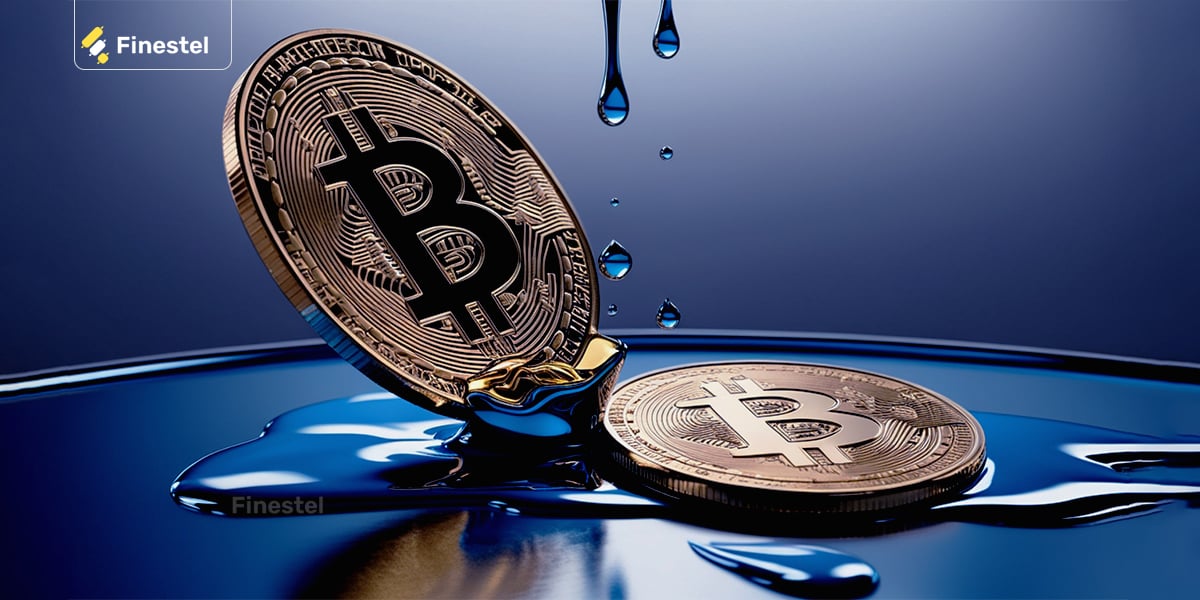
In crypto, this often shows up during sudden pumps or dumps, which are usually caused by liquidation events. Imagine a coin surging 10% in one minute. By the time your market order hits, the price could already be much higher. The same thing happens in forex when big economic news like interest rate decisions or job reports drops.
Another cause is thin liquidity. If there aren’t enough buyers or sellers at your target price, your order “jumps” to the next available level. And remember, the bigger your order is, the more it moves the price itself. So, it leads to more slippage. Of course, this type of slippage rarely happens in forex, because it’s the most liquid market in the world. But you should expect it in crypto.
Some other small factors, like internet latency, broker execution speed, and exchange congestion, can make it worse. So, it isn’t always the market. Sometimes, the reason is your connection to the market.
How to Measure Slippage?
Before you can manage slippage, you need to measure it. Luckily, the math is quite simple. As I’ve already mentioned, it’s the difference between the expected price and the executed price. But the measurement units are different in forex and crypto.
In forex, traders usually calculate price differences in pips. The same goes for slippage, as it’s essentially a price difference. For example, if you wanted to buy EURUSD at 1.2000 but got filled at 1.2003, that’s 0.3 pips of slippage.
In crypto, it’s often shown as a percentage or dollar amount. So, buying Bitcoin at $60,000 but getting filled at $60,150 equals a 0.25% or $150 slippage.
What Is Slippage Tolerance?
On decentralized crypto exchanges, you’ll see something called slippage tolerance. It’s the maximum price difference you’re willing to accept, and you should set it when placing the order.
If the slippage goes beyond that, your order won’t execute. So this way, you can prevent overpaying in volatile conditions, especially in DEXs where liquidity is thin.
Slippage in Algorithmic Trading
In algorithmic forex trading, especially in MQL4 or MQL5, there’s even a slippage parameter coded directly into the strategy. It defines how much price deviation your bot can handle before skipping the trade. So, as you see, slippage is not just a negligible expense, and you should always account for it.
The Real Cost of Slippage
This article is titled: What is slippage and how to reduce it in crypto and forex trading. But why reduce it? Because it’s costly.
Slippage might look small on a single trade, but it adds up fast. A few dollars here and there can quietly shrink your profits, especially if you trade often or with large positions.
Let’s say I lose just an average of 0.2% per $1,000 trade due to slippage. Over hundreds or thousands of trades, that can reach thousands of dollars in costs you pay for slippage. And that’s just me. For fund managers or algo traders, it can become much larger and completely change backtesting results versus live performance.
There’s also something called a crypto slippage fee. On decentralized exchanges like Uniswap or PancakeSwap, when prices shift before your order executes, that difference is treated as part of the transaction fee.
Why Slippage Is Worse in 2025
Now, you’d guess that with the recent advancements in technology, crypto and forex slippage has gotten better. I hate to break it to you, but that’s not the case. Markets are faster, more volatile, and more unpredictable than ever. That’s why slippage hits harder today than it did a few years ago.
In crypto, sudden pumps and dumps driven by futures market liquidations, whales, or AI-based trading bots cause huge price jumps within seconds. Liquidity spreads across hundreds of exchanges and pairs, making it harder to get consistent fills. On high slippage cryptos like smaller altcoins, even a few thousand dollars can move the price dramatically, which is a perfect setup for high crypto slippage.
Shifting to forex, macro uncertainty keeps volatility high. Central banks change tone quickly, and economic data often shocks the market. Add algorithmic trading and high-frequency systems reacting in milliseconds. Needless to say, your manual order barely stands a chance to catch the best price.
Liquidity fragmentation is another big factor. Between CEXs and DEXs in crypto, or between ECNs and retail brokers in forex, price differences are everywhere.
How to Reduce Slippage in Crypto and Forex
Forex and crypto slippage management depends on what you trade. The causes are similar, as I mentioned: volatility and liquidity. But the best solutions differ slightly between crypto and forex.
|
Category |
Crypto Solutions |
Forex Solutions |
|
Order Type |
Use limit orders or DEX slippage tolerance |
Use limit orders or stop-limit orders |
|
Trading Time |
Trade during high-exchange volume (U.S. hours) |
Trade during the London–New York overlap |
|
Liquidity Source |
Stick to top-tier exchanges or pairs |
Use ECN/STP brokers with deep liquidity |
|
Volatility Control |
Avoid low-cap coins and major announcements |
Avoid news releases and illiquid sessions |
|
Order Size |
Split large trades into smaller ones |
Use partial fills or trade in sessions with tighter spreads |
|
Tools & Tech |
Use bots or copy systems with slippage management (e.g., Finestel) |
Use execution algos (TWAP, VWAP) or reliable MT4/MT5 settings |
Slippage Management in Crypto
Crypto markets are open 24/7 and move fast. So liquidity and timing matter more than anything. The best ways to reduce crypto slippage are by using limit orders instead of market orders, and sticking to major exchanges and high-volume pairs like BTC/USDT and ETH/USDT.
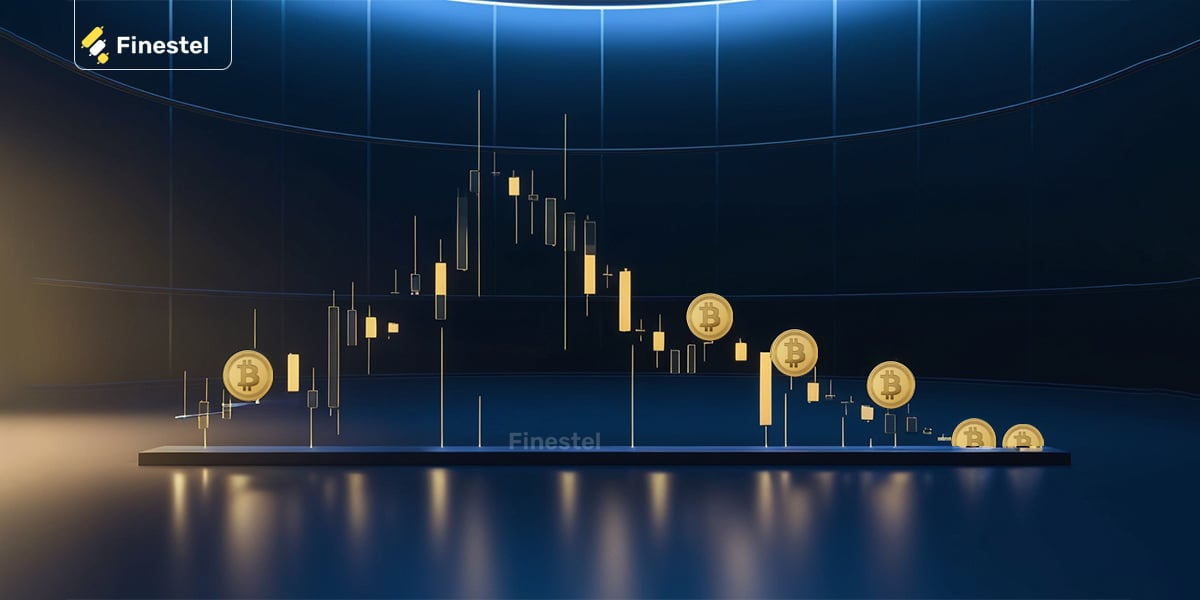
If you trade on decentralized exchanges like Uniswap or PancakeSwap, always set a tight slippage tolerance. A range between 0.1% and 0.5% usually works for large-cap coins. But you might need higher for low-liquidity tokens.
Finally, if you use automation, choose trading bots or copy trading platforms that actively manage slippage and liquidity, not just basic copying trading. Finestel is built specifically for that purpose. It’s designed for professional traders, asset managers, and institutions who handle multiple accounts and large portfolios, where even small execution delays can make a big difference.
Here’s how Finestel helps reduce slippage and improve trade quality:
- Limit as Market: This feature ensures followers’ trades execute instantly when the lead trader’s order triggers. Instead of waiting for a limit order to fill (and possibly missing the move), it automatically converts it into a market order at the moment of execution. The result is faster fills, fewer missed trades, and tighter price tracking, even in volatile markets.
- Large Order Smart Execution: For asset managers and institutional traders handling big positions, this system dynamically adjusts execution speed to match live market liquidity. It breaks down large orders over time, minimizing price impact and slippage while keeping trades aligned with real-time market volume.
Slippage Reduction in Forex
The easiest way for FX slippage management is to trade during liquid sessions, especially the London–New York overlap. That’s when spreads are tight and trade volume is at its highest.
I’d also suggest you avoid trading around major announcements like Non-Farm Payrolls or CPI reports. During these moments, price jumps instantly, and brokers widen spreads or reject orders.
Moreover, always use limit or stop-limit orders when possible. Market orders execute instantly, but they give up control of the price. If you use MetaTrader, you can even set slippage tolerance in MQL4/MQL5. That tells your platform how much deviation you can accept before skipping the trade.
Finally, choose ECN or STP brokers with deep liquidity. These connect your trades directly to liquidity providers instead of internal dealing desks. That means less delay and more accurate fills. For institutional traders, using execution algorithms like TWAP or VWAP can also help spread entries over time and reduce market impact.
Tools and Platforms for Slippage Management
By now, you should know that if you trade actively, relying on manual control isn’t enough. You need tools that monitor execution and manage slippage automatically.
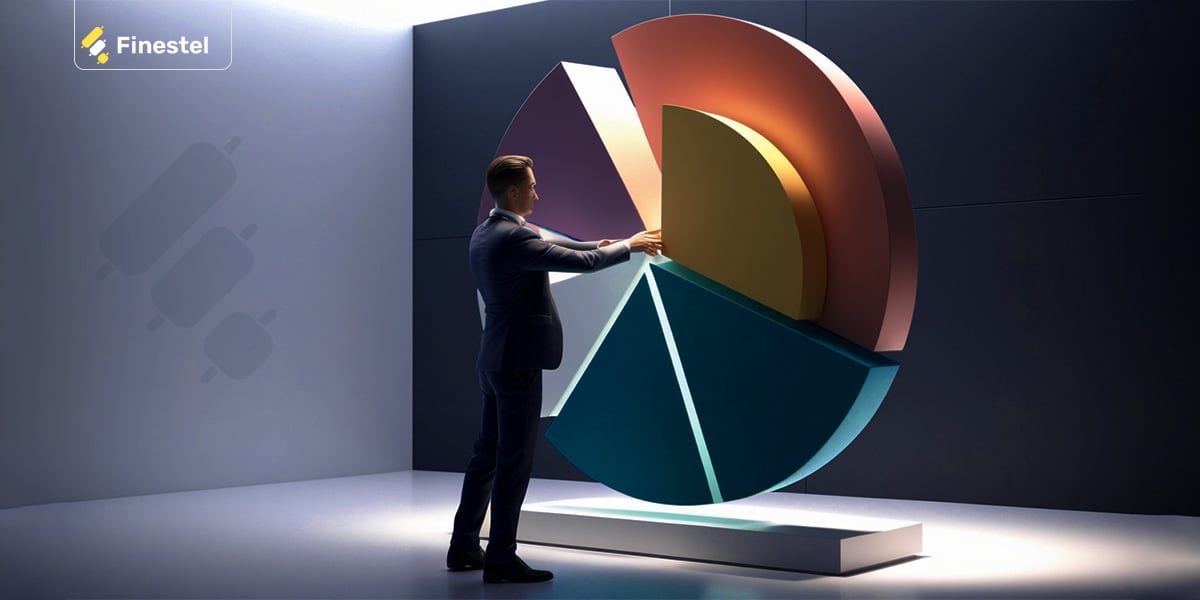
For crypto slippage management, the best tools are aggregators and smart order routers. They scan multiple exchanges and pick the best price for your order.
Some copy trading and portfolio management platforms, like our own Finestel, take this a step further. We synchronize trade execution across accounts with minimal delay. This applies to all of our services, including our brand new trading terminal.
For forex, platforms like MetaTrader (MT4/MT5) and cTrader allow traders to set custom slippage limits or even automate their execution rules through scripts. Institutional desks use liquidity management systems that connect to multiple ECNs or banks, routing orders dynamically to get the best fill.
Some traders also use execution analytics tools that measure historical slippage, latency, and spread changes during different sessions. By tracking these metrics, you can learn when slippage tends to spike and adjust your strategy accordingly.
Common Mistakes Traders Make With Slippage
Most traders don’t realize how much slippage costs them until it’s too late. And the funny thing is that the issue isn’t always the market. It’s often how they trade.
- Using market orders during volatility: When prices are jumping, a market order says, “fill me at any price.” That often leads to bad fills. Use limit orders instead, even if it means waiting longer to get in.
- Trading illiquid pairs or coins: In crypto, small-cap tokens can move several percent from one trade. In forex, exotic pairs like USD/TRY or GBP/NZD have wide spreads and poor liquidity, too. So, I’d advise you to stick to major pairs or top crypto assets to reduce slippage.
- Ignoring spreads: Spreads widen during volatile or low-volume periods. When that happens, your entry price can shift before execution, which causes slippage.
- Poor timing around news: Entering just before major economic reports or announcements often causes heavy slippage.
- Falling for “no slippage” marketing: Accept this from me: no broker or exchange can guarantee zero slippage. The real goal is controlling it, and that’s what you should do.
If you’re looking for more, check out our article on crypto liquidity challenges and solutions in 2025.
Slippage and Its Management in an Infographic
Conclusion
Slippage is a natural part of trading, not a mistake. It’s the hidden cost that comes with today’s fast markets. And, unfortunately, the faster the market is, the bigger the impact of slippage. But the good news is you can manage it. By focusing on liquidity, timing, and order type, you can reduce how often slippage hurts your trades.
For more advanced setups, platforms with built-in forex and crypto slippage management, like Finestel, make a big difference, especially for fund managers or traders running multiple accounts, who are Finestel’s primary clientele.
FAQs
What causes slippage in forex and crypto trading?
Slippage happens when prices change between the moment you place your order and when it’s executed. It’s usually caused by high volatility, thin liquidity, or slow execution speed — all common in fast-moving markets.
Can slippage ever be positive?
Yes. If your trade gets filled at a better price than expected, that’s called positive slippage. It’s rare but possible, especially in calm markets with plenty of liquidity.
How do you set the right slippage tolerance on DEXs?
On decentralized exchanges like Uniswap, you can define how much price movement you’re willing to accept. A tight tolerance (around 0.1%–0.5%) prevents overpaying but might cause failed transactions in volatile markets.
What’s the best way to reduce forex slippage during news events?
Avoid trading a few minutes before and after major releases like CPI, NFP, or FOMC. Liquidity drops and spreads widen instantly during these times. Waiting until the market stabilizes helps you get better fills.
Are “no slippage” brokers or exchanges real?
Not really. Every platform faces price movement and latency. The best brokers and exchanges just minimize it with deep liquidity and fast execution, but zero slippage isn’t realistic.

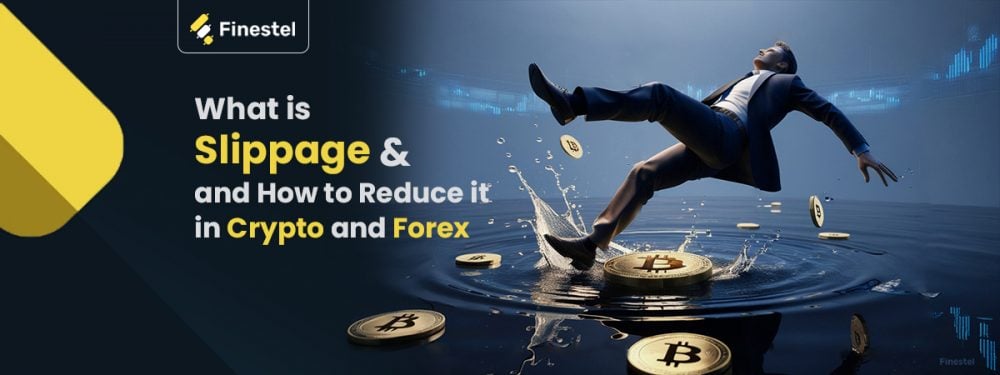
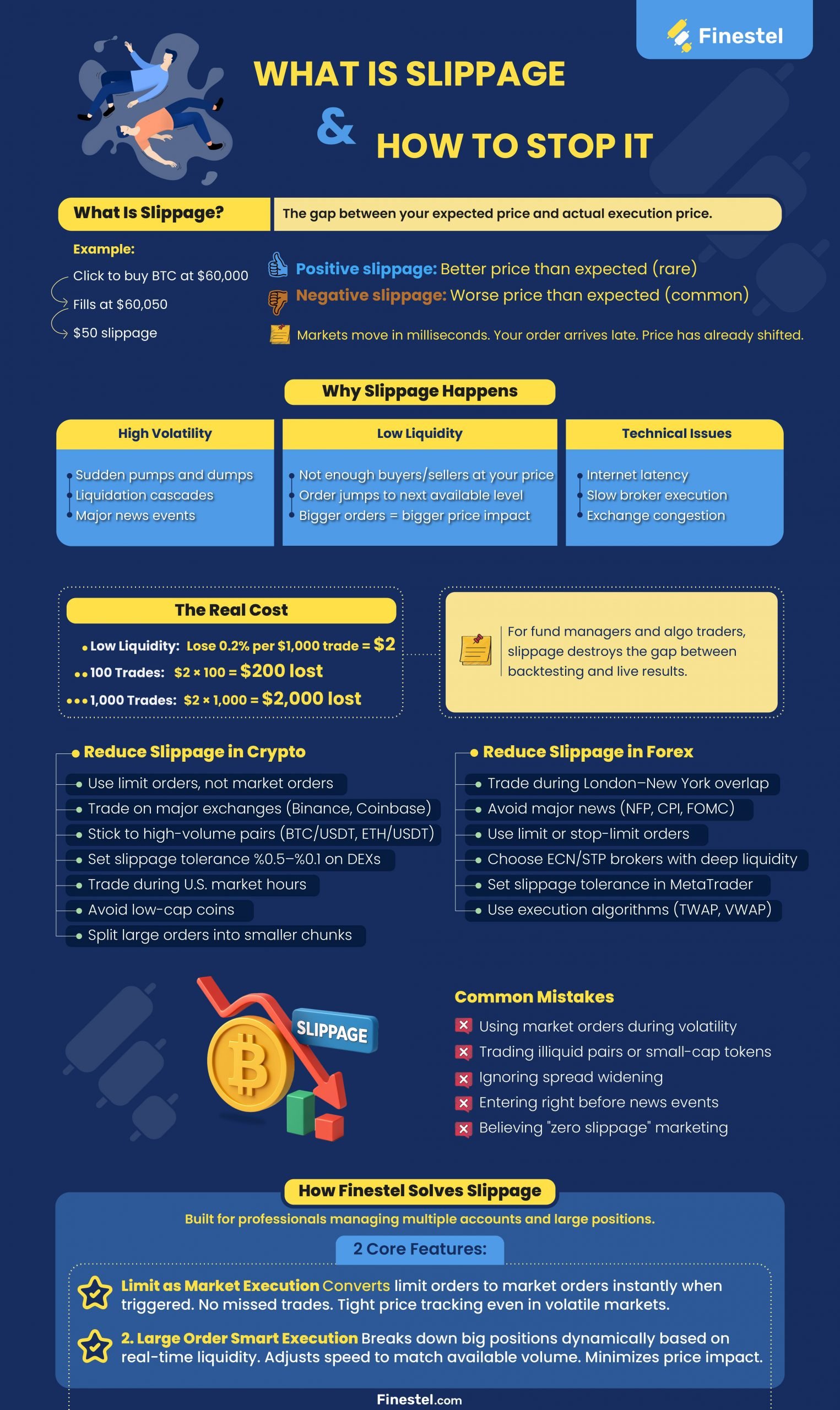

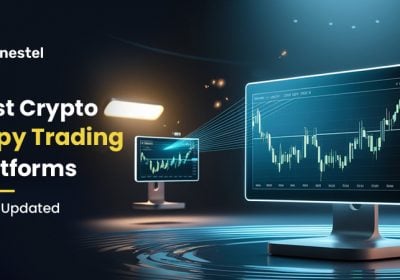


Leave a Reply